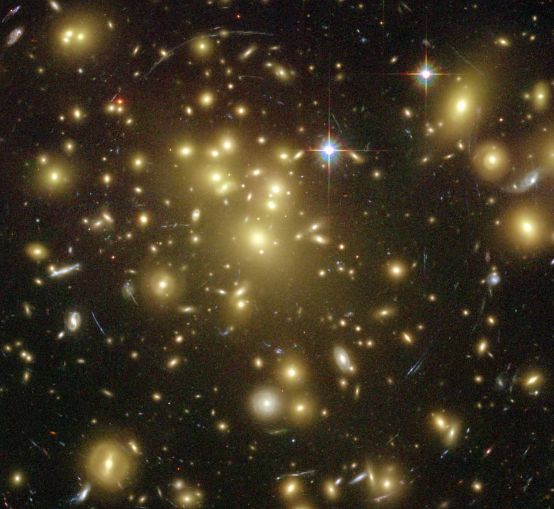Credit & Copyright: N. Benitez (JHU),
T. Broadhurst (Hebrew Univ.),
H. Ford (JHU),
M. Clampin (STScI),
G. Hartig (STScI), G. Illingworth (UCO/Lick), ACS Science Team, ESA, NASA
Explanation:
Two billion
light-years away, galaxy cluster Abell 1689 is
one of the most massive objects in the Universe.
In
this view from the Hubble Space Telescope's
Advanced Camera for Surveys,
Abell 1689 is seen to warp space as predicted by
Einstein's
theory of gravity -- bending light
from individual galaxies which lie
behind the cluster to produce multiple, curved images.
The power of this enormous
gravitational lens depends on its mass, but
the visible matter,
in the form of the cluster's yellowish galaxies, only accounts
for about one percent of the mass needed to make the observed
bluish arcing images of background galaxies.
In fact, most of the gravitational mass required
to
warp space enough to explain this cosmic scale lensing is in the
form of still mysterious
dark matter.
As the dominant source of the cluster's gravity,
the dark matter's
unseen presence is mapped out
by the lensed arcs and
distorted
background galaxy images.
G. Hartig (STScI), G. Illingworth (UCO/Lick), ACS Science Team, ESA, NASA
1999 2000 2001 2002 2003 2004 2005 2006 2007 2008 2009 2010 2011 2012 2013 2014 2015 2016 2017 2018 2019 2020 2021 2022 2023 2024 2025 |
Yanvar' Fevral' Mart Aprel' Mai Iyun' Iyul' Avgust Sentyabr' Oktyabr' Noyabr' Dekabr' |
NASA Web Site Statements, Warnings, and Disclaimers
NASA Official: Jay Norris. Specific rights apply.
A service of: LHEA at NASA / GSFC
& Michigan Tech. U.
|
Publikacii s klyuchevymi slovami:
Skoplenie galaktik - abell 1689 - gravitacionnoe linzirovanie
Publikacii so slovami: Skoplenie galaktik - abell 1689 - gravitacionnoe linzirovanie | |
Sm. takzhe:
Vse publikacii na tu zhe temu >> | |
